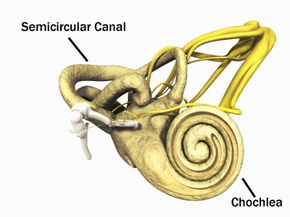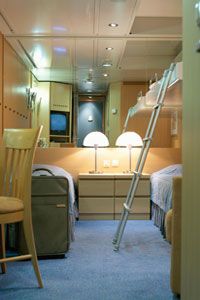food, drink and fun. You can dance, gamble, take a class, see a show, canoodle, admire ice sculptures, watch movies, swim, exercise and eat and drink your fill every day. This is the sunny side of cruising, and if you're into it, you aren't alone. Cruise Lines International Association projects that 34 million adults over 25 years old will go on a cruise in the next three years [source: Cruise Lines International Association]. But there's a dark side to your Love Boat experience.
There aren't any definitive statistics to indicate what percentage of cruise ship passengers get seasick, but it's believed to be pretty low for a few reasons. For one, cruise ships are huge. A standard cruise ship these days is roughly 1,000 feet (304 meters) long and 100 feet (30.4 meters) wide. They weigh more than 70,000 tons (63,500 metric tons) and can carry close to 3,000 passengers on board. They also extend as far as 30 feet (9 meters) below sea level. In the ocean, a large vessel is more stable against the rocking and rolling of the sea. Cruise ships also have stabilizers built into their structure that keep them as steady as possible. But even cruise ships aren't immune to exceptionally rough seas.
Advertisement
You're more likely to get seasick on a smaller vessel. So if you have a day of deep-sea fishing planned on a chartered boat, prepare to feel some ill effects. Seasickness is a form of motion sickness. It's triggered when parts of your body that detect motion, like your eyes and inner ear, send unexpected or conflicting messages to the brain. Another way to say it is that it's a reaction to real, perceived or anticipated motion. We'll get into how this occurs in more detail later. Motion sickness isn't strictly for boat travelers. You can get motion sickness in a car, on a plane or on a roller coaster. You can also experience it watching a movie with shaky camera work, looking through a microscope or playing a video game. Pilots can experience it in flight simulators.
Seasickness is most prevalent in children ages two to 12, women and the elderly. If you have migraine headaches, you're also more likely to suffer from it, although it's unclear exactly why. Even though the percentage of cruisers that get seasick is low, imagine the worst-case scenario -- you're rendered incapacitated and left hugging your cabin toilet the entire voyage. Over the next few pages, we'll look into the science behind seasickness and what you can do to prevent it and deal with it when you can't avoid it.
Advertisement



